Posted by Cameron on 01.31.10 8:57 PM
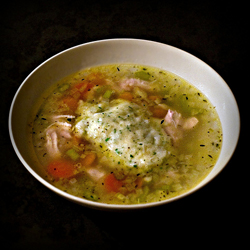 The display read 101°F when the digital thermometer beeped, which might have been okay if we were proofing yeast. But we were in the bedroom, not the kitchen — and the thermometer was under the tongue of my very achy, very sick wife. “You are not going to work,” I said. “And I am coming home early and making chicken soup.”
The display read 101°F when the digital thermometer beeped, which might have been okay if we were proofing yeast. But we were in the bedroom, not the kitchen — and the thermometer was under the tongue of my very achy, very sick wife. “You are not going to work,” I said. “And I am coming home early and making chicken soup.”
I don’t have an operatic range as a cook, but chicken soup is one of the dishes that I do well. I wish I could say that I follow a Secret Family Recipe steeped in a Romantic Patina of age and memory, written carefully in cursive on an index card that is Stained with Character and Creased with Use.
But the truth is that I found my chicken soup in a cookbook while we were living in Seattle, and I was first drawn to it by the fact that it had a gimmick: You start with a whole chicken and some vegetables, and end up two hours later with soup. The trick is accomplished by cutting the chicken (except for the breast) — bones and all — into very small pieces and sautéeing them before making a super-quick broth. It’s fast, it’s easy, it’s reliable, and it tastes fantastic.
I can modestly admit to having made a few small discoveries and tweaks to the basic recipe. The original calls for a 4-pound chicken, but I discovered that the larger the bird, the more tasty the soup. These days, we’re getting lovely little 3- to 4-pound birds from the Soul Food Farms CSA, so I add some feet, necks, and wings from the stock bag in the freezer to bring the total weight up to five pounds. I also cut my onions as finely as possible instead of the original medium dice, because I like them to melt into the soup.
Finally, the original recipe calls for noodles, but I much prefer dumplings. I make a slightly wetter version of my standard biscuit dough and — when the soup is almost done — float globs of the dough on top, cover the pot with a lid, and steam for about 10 minutes.

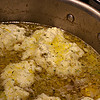
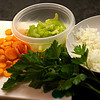


Hearty Chicken Soup
– adapted from The Perfect Recipe
3 T vegetable oil or chicken fat
2 medium onions, cut into small dice
1 whole chicken (about 5 lbs.; add extra necks and/or wings if your bird is smaller)
2 bay leaves
1 large carrot, sliced 1/4 inch thick
1 celery stalk, sliced 1/4 inch thick
1/2 teaspoon dried thyme leaves
1/4 cup minced fresh parsley leaves
Salt
Dumplings
– adapted from Joy of Cooking
1 3/4 cups all-purpose flour
1/2 tsp salt
3 tsp double-acting baking powder
6 T chilled butter
3/4 cup plus 1 T milk
Cut up the whole chicken as if you were going to cook it in parts, splitting the breast into two pieces, but keeping the meat on the bone. (Cooking for Engineers has a nice post on breaking down a chicken. Alton Brown also does a good tutorial, although he takes the breast meat off the bone.)
Set aside the breasts and use a cleaver or poultry shears to hack the rest of the chicken — including the back, neck, and feet if you have them — into 1- or 2-inch chunks. Cut through the bones!
Heat the oil or fat over medium-high heat in a large soup pot. Add half of the chopped onion and all of the chicken pieces except the breast. Sauté until the chicken is no longer pink (I like to see some brown on the chicken pieces, but that can be tough to do in a crowded pot. Be careful not to burn the onions!). Reduce heat to low, cover, and simmer until the chicken releases its juices, about 20 minutes. Increase the heat to high and add 2 quarts of cold water, along with the chicken breasts, 2 teaspoons of salt, and bay leaves. Bring to a simmer, then cover, reduce heat to low and barely simmer until chicken breast is cooked and the broth is rich and flavorful, about 20 minutes.
Skim the fat from the soup and reserve it, then remove chicken breast from the pot and set aside. Strain the broth into a large bowl and discard the rest of the chicken pieces and bones. When the breast is cool enough to handle, remove the skin, and then remove the meat from the bones, shredding it into bite-sized pieces. Discard the skin and bones.
Return the pot to medium-high heat. Add 2 to 4 tablespoons of the reserved chicken fat, the remaining onion, the carrot and the celery, and a pinch of salt. Sauté until softened, about 5 minutes. Add thyme, broth, and shredded chicken. Simmer until the vegetables are tender and the flavors meld, 10 to 15 minutes.
If you like pasta, you can add two cups of egg noodles and cook until tender. Taste the soup and correct the seasonings — it will almost certainly need more salt. However, be careful with the salt if you’re going to add dumplings, as most dumpling/biscuit dough has salt in it somewhere… and I wouldn’t do both dumplings and noodles.
To make the dumplings, put the flour, salt, and baking powder in a food processor and pulse until well mixed. Add the butter, cut into tablespoon-sized chunks. Pulse until thoroughly mixed. Add the milk and pulse until the dough comes together. Drop globs of dough from a spoon onto the surface of the soup. Cover and simmer until the dumplings are cooked through, approximately 10 minutes.
Sprinkle with the parsley and serve.
Farmers and food artisans who created the ingredients for this week’s meal: 
Spring Hill Cheese Company, Petaluma: butter
Soul Food Farm, Vacaville: chicken
Guisto’s Vita-Grain, South San Francisco: sea salt, flour
Catalán Family Farm, Hollister: onion, celery
Straus Creamery, Petaluma: milk
…and our own homegrown thyme, carrots, bay, and parsley
(Exemption: baking powder)
cookbooks, cooking, Dark Days challenge, locavore, recipes
8 Comments »




Posted by Anita on 01.25.10 6:27 PM
 Failure may be too strong of a word.
Failure may be too strong of a word.
In fact, I’m sure it is. On the other hand, saying “it tasted fine, but wasn’t really worth the effort” doesn’t make a very good headline. But it does neatly sum up this locavore household’s unanimous verdict on our Dark Days Challenge meal this week.
I’ve had Gourmet‘s recipe for Oeufs à la Cantalienne in my clippings for at least three years. The headnotes promise “the soft, yolky flavor of eggs Benedict but without all the hassle”, a notion that appealed to me as I tried to figure out a way to make midweek breakfast-for-dinner more exciting.
We’re pretty handy with eggs, but I think a novice cook especially might find this recipe — which entails buttering ramekins, separating eggs, keeping yolks intact, whipping egg whites, folding cheese, smoothing egg whites, and dolloping créme fraîche — at least as daunting as toasting muffins, poaching eggs, and whisking up a batch of Hollandaise.
When I went looking for other versions of this dish to see where I might have gone astray, I discovered that Molly – whose culinary opinion I trust — loved this recipe, and her photos of her friend Jimmy’s version look much more promising than ours did. I feel terrible casting aspersions based on a single lackluster effort, but on the other hand, this is not a recipe I’m anxious to try again. Faced with the same ingredients, next time out I’m just as likely to make a nice cheese-and-herb omelette to go with our home fries.
So here’s the recipe, in all of its glory. If you try it and like it (or even if you loathe it), I’d can’t wait to hear about it.

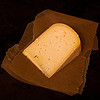



Oeufs à la Cantalienne (Baked Eggs with Cheese)
– adapted from Gourmet
Butter, for greasing ramekins
6 large eggs
1/4 tsp salt
1/4 tsp black pepper
1/8 tsp freshly grated nutmeg
1/8 tsp cream of tartar
3 oz grated Cantal or other mild, semi-firm cow’s cheese (we used Carmody)
6 T créme fraîche
1 T chopped fresh herbs
Adjust oven rack to middle position and preheat oven to 350°F. Butter six 8-oz ramekins.
Separate the eggs, carefully sliding whole, unbroken yolks into a small bowl of cold water and putting whites in a large bowl. Add salt, pepper, nutmeg, and cream of tartar to the egg whites. Using an electric mixer at medium-high speed, beat whites with until they just hold stiff peaks.
Gently fold half of cheese into the beaten whites, taking care not to deflate the mixture, then divide among ramekins. Smooth the top of the egg whites, then make an indentation in the center of each ramekin.
Using your fingers, carefully remove yolks from water one at a time and put a yolk in each indentation. Stir créme fraîche, and dollop 1 tablespoon on top of each yolk; sprinkle eggs with remaining cheese. Transfer ramekins to a rimmed cookie sheet.
Bake until whites are puffed and pale golden but yolks still jiggle slightly, 10 to 14 minutes. Sprinkle with herbs and serve immediately.
Farmers and food artisans who created the ingredients for this week’s meal: 
Spring Hill Cheese Company, Petaluma: butter
Soul Food Farm, Vacaville: eggs
Guisto’s Vita-Grain, South San Francisco: sea salt
Bellwether Farms, Sonoma: crème fraîche, Carmody cheese
Little Organic Farm, Marin: potatoes (for homefries)
Catalán Family Farm, Hollister: onion (for homefries)
…and our own homegrown thyme.
(Exemptions: black pepper, nutmeg, cream of tartar)
Dark Days challenge, locavore
2 Comments »




Posted by Anita on 01.17.10 8:57 PM
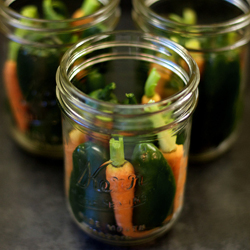 I really didn’t intend to feature yet another Mexican stew this week, but it’s inadvertently turned into a south-of-the-border comfort food month at our house. We had something entirely different planned for this week’s Dark Days Challenge meal, but our schedule got scrambled — by good things — so our fallback plan moved into the spotlight.
I really didn’t intend to feature yet another Mexican stew this week, but it’s inadvertently turned into a south-of-the-border comfort food month at our house. We had something entirely different planned for this week’s Dark Days Challenge meal, but our schedule got scrambled — by good things — so our fallback plan moved into the spotlight.
Because we’re so addicted to Latin flavors, we put up many of the necessary ingredients in the summer, at the height of their season. For this recipe, we used roasted, skinned tomatillos that we froze in bags, plus jalapeño peppers pickled in a traditional salty brine. Our cilantro’s wintered over quite well, so we don’t even have to claim exemptions this week.
This bean-enriched variation on chile verde isn’t a particularly beautiful dish, but it’s delicious. If you want to make it in the slow cooker, the original recipe omits the stock and layers all of the ingredients in the crock — starting with the tomatillos, followed by the rest of the vegetables, and the pork at the top. Cover and slow-cook on high for 6 hours, then add the cooked beans just before serving.

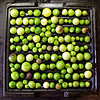
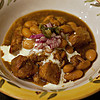


Puerco en Salsa Verde – Tomatillo Pork Braise with White Beans
– adapted from Mexican Everyday
1 to 1-1/4 pounds boneless pork shoulder, cut into 2-inch cubes
1 pound tomatillos
3 pickled jalapeños (divided use)
1 medium white or red onion, diced (divided use)
2 garlic cloves
1/3 cup loosely packed rough-chopped cilantro (divided use)
2 cups chicken or pork stock
2 cups cooked cannellini beans, drained
Mexican crema, sour cream, or creme fraiche, as desired
Salt the pork cubes, and set aside. Husk the tomatillos, then rinse and cut into quarters. Stem and halve the jalapeños, cut them in half, and scrape out the seeds; dice one of the chiles and set aside for garnish.
Heat oil or drippings in a large saucepan or small Dutch oven over medium heat. When shimmering, add the pork in a single layer and saute until golden brown on all sides. Remove the browned meat to a clean plate. Add about 2/3 of the diced onion to the pan and saute until soft. Add the garlic and continue to cook until garlic is golden. Add the jalapeños and half of the cilantro and cook until just soft. Add the prepared tomatillos and jalapenos, and return the meat to the pan. Add enough of the stock to come a little more than halfway up the side of the pork. Cover and simmer gently, 3 hours or more until the pork is tender, adding more stock as needed to keep the meat partly submerged.
When the pork is thoroughly tender, remove the meat to a clean plate with tongs. Puree the sauce with an immersion blender (or in batches — carefully — in a standard blender; then return to pan). Return the meat to the pan, and add the cooked beans. Taste and season with salt as needed, adding more stock or water to keep the sauce at the consistency of a creamy soup. Bring the dish to a simmer and serve warm, with remaining cilantro, onions, pickled jalapeños, and crema for garnish.
Farmers and food artisans who created the ingredients for this week’s meal: 
Marin Sun Farms, Point Reyes: pork shoulder
Catalán Family Farm, Hollister: tomatillos, onion, jalapeños
Iacopi, Half Moon Bay: garlic
Rancho Gordo, Napa: cannellini beans
Bellwether Farms, Sonoma: crème fraiche
Guisto’s Vita-Grain, South San Francisco: sea salt
…and our own homegrown cilantro and homemade pork stock
Dark Days challenge, locavore, Mexican, recipes
6 Comments »




Posted by Anita on 01.10.10 10:01 PM
 To take the chill out of winter, I like to make a big pot of pozole, the traditional Mexican pork stew. It’s one of those meals that leaves you feeling warm inside, even hours after you’ve finished dinner. I was feeling deprived that I hadn’t gotten around to it yet; I’d been waiting for a lazy weekend to appear, when a long Saturday might give me enough time to tackle the various steps.
To take the chill out of winter, I like to make a big pot of pozole, the traditional Mexican pork stew. It’s one of those meals that leaves you feeling warm inside, even hours after you’ve finished dinner. I was feeling deprived that I hadn’t gotten around to it yet; I’d been waiting for a lazy weekend to appear, when a long Saturday might give me enough time to tackle the various steps.
I’d bought the hominy and the dried chiles, even squirreled away a particularly meaty piece of pork, but didn’t get around to actually putting the stew together until it was time to make this week’s Dark Days Challenge meal.
Pozole verde, the version made with tomatillos and green chiles, is a staple in our house. But the deeper, complex brick-colored rojo style isn’t something we’ve made as often. Local dried chiles are significantly more expensive than the fresh varieties, but in the winter, when cooking with green chiles means dipping into our precious freezer stash, it doesn’t seem so profligate to splurge on a few dried anchos.
Steve Sando — who knows a few things about new-world grains — says that “in America, the [prepared] corn and the finished dish are called posole. In Mexico, only the finished dish is called pozole.” But I’m not fussy. Green or red, with an S or with a Z… I’m an equal opportunity pozole-loving fool.
Pozole is typically fiesta fare, so most recipes serve a crowd. At the moment, we’re short on freezer space, so we scaled this recipe to make just one dinner for two plus a pair of lunch-sized leftovers.
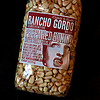

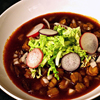


Pozole Rojo – Red Pork and Hominy Stew
– adapted from Mexico One Plate at a Time
1/2 pound dried corn prepared for pozole (such as Rancho Gordo White Corn Posole)
5 cloves garlic, peeled and halved
1 meaty piece of bone-in pork, about 1.5 pounds
– (we used shank; shoulder steaks are also good)
1 small pork trotter
1 white onion, chopped (divided use)
3 medium ancho chiles, stemmed and seeded
2 cups shredded green cabbage
5 radishes, sliced
1T dry Mexican oregano
2 tsp ground dried hot chile (optional, to taste)
thick tortilla chips or tostadas
In a large pot, combine 2 quarts of water with the hominy and garlic. Bring to a boil; partially cover the pot and simmer gently until the corn is thoroughly tender, 2 to 3 hours; many will split open. Season with salt and cool in the liquid.
While the corn simmers, place the pork and trotter in another pot; cover with water, add 2 tsp salt, and bring to a boil. Skim off any foam that rises to the surface, then add half of the chopped onion. Simmer over medium-low heat, partially covered, until all of the meat is tender, at least 2 hours. Cool the meat in the broth, then remove it to a plate. Skim the fat from the broth, or cool overnight and remove the solidified fat the next morning. You should have about 3 cups of broth. Pull the meat off the bones and chop into 3/4-inch shreds. (There may not be much usable meat on the trotter, but it’s there mostly for body and texture; you can discard the chewy bits unless you’re feeling muy macho.) Depending on the cut of meat you used, you’ll have anywhere from 1 to 2 cups of meat.
Soak the ancho chiles in enough hot water to cover, for about 20 minutes. Puree the chiles and their liquid in a blender. When the corn is tender, press the chile puree through a medium-mesh sieve into the corn broth. Add the pork broth, shredded meat, and 3/4 tsp salt; partially cover, and simmer 1 hour. (At this point, the stew can — and ideally should — be cooled and refrigerated for a day or two; its flavor improves with time. Reheat to a simmer before serving.)
Before serving, check consistency. (Bayless says “The stew should look hearty — chock-full of hominy with bits of meat — but brothy enough to be thought of as a soup or brothy stew.”) If necessary, add unsalted chicken stock or water to return to the correct thickness. Taste and adjust salt.
Set out bowls of condiments — the remaining chopped onion, shredded cabbage, sliced radishes, oregano, ground chile, and tostadas — on the table for each diner to add to their bowl as they like.
Makes 4 servings
Farmers and food artisans who created the ingredients for this week’s meal: 
Iacopi, Half Moon Bay: garlic
Catalán Family Farm, Hollister: onions
Tierra Vegatables, Santa Rosa: ancho chiles
Dirty Girl Produce, Santa Cruz: green cabbage & radishes
Marin Sun Farms, Point Reyes: pork trotter
Rancho Gordo, Napa: dried hominy, ground red chile, Mexican oregano
Shasta Valley Farm, Gazelle (via Live Culture‘s Pork Prom): Mangalitsa pork shank
Primavera, Sonoma: Corn tortillas (for homemade tostadas)
Guisto’s Vita-Grain, South San Francisco: sea salt
Dark Days challenge, locavore, Mexican, recipes
5 Comments »




Posted by Anita on 01.03.10 11:40 PM
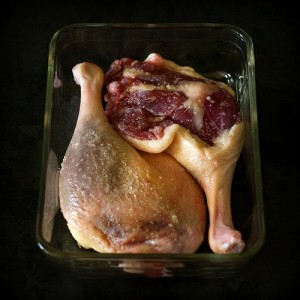 If it’s New Year’s week, it must be time for cassoulet at our house. For this week’s Dark Days Challenge meal, we used the same streamlined recipe we’ve been making for the last couple of years. But this year, we went back to the classic preparation, and made our own duck confit.
If it’s New Year’s week, it must be time for cassoulet at our house. For this week’s Dark Days Challenge meal, we used the same streamlined recipe we’ve been making for the last couple of years. But this year, we went back to the classic preparation, and made our own duck confit.
We were lucky enough, last fall, to buy one of the Pekin ducks that Massa Organics was using for pest control in their rice fields. We parted out the bird, setting aside the breasts for searing, making stock out of the carcass, rendering down the fat and skin, and preserving the legs in the rendered fat.
One of my new year’s resolutions is to eat more food grown by people I know in 2010. We already do a pretty good job of finding local sources, but it’s always that much sweeter when we know the families behind our dinner. This cassoulet was a pretty good first step — we’re friends with three of the producers: Steve Sando from Rancho Gordo, Taylor Boetticher from Fatted Calf, and Greg Massa of Massa Organics. We know many of our other farmers by sight from our market trips, but in the next year we’re going to try and become even more familiar with the people who put food on our plates.
The recipe below may seem long, but trust me when I say that it’s a gross simplification of Judy Rogers’s original recipe, which runs to 6 full pages. Just like her Mock Porchetta (and pretty much every other Zuni recipe), the length isn’t so much an indicator of complexity or difficulty, but rather a mix of thoughtful hints, step-by-step signposts, and thought-provoking commentary. In the book, Rogers details how various duck breeds adapt to the master recipe, recounts her laborious process to find the best variety of salt for curing, offers ideas on how to get enough fat to cover your meat, makes suggestions for adapting the recipe to duck breasts or gizzards, and provides a number of serving ideas. It’s a treatise on duck confit in all its glory, and I highly recommend you read it at least once in its entirety. (If you don’t already own a copy, it’s well worth picking up. You don’t have to take my word for it: Eat Me Daily named it one of their top cookbooks of the past decade.)


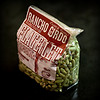
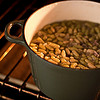
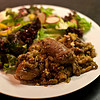
Duck Confit
– adapted and condensed from The Zuni Cafe Cookbook
4 whole duck legs (legs and thighs attached)
1/3 oz (approximately 2 tsp) sea salt per pound of meat
rendered duck fat, sufficient to cover the legs
– (approximately 2 cups fat per pound of meat) plus a little extra for insurance
Rinse the legs well and pat dry, trimming off any ragged edges of skin or fat. Working on a sheet of parchment, salt the legs all over, a little more on the thick parts and less on the bony legs and ankles. Roll the legs in the salt left on the parchment. Arrange the legs in a single layer in a wide glass, ceramic, or stainless container, skin side down. Refrigerate for 18 to 24 hours, depending on the size and meatiness of the legs.
Rinse the legs well, one at a time, under cold running water; do not soak or you will end up with waterlogged meat. The flesh should feel firm, but knead the excess salt out of any areas that feel especially hard. Dry the rinsed legs on a clean towel and pat dry. Test for saltiness by trimming off a bit of meat and simmering it in duck fat for 5 minutes. If it tastes too salty, rinse and dry each leg again. (Rogers says it should be reminiscent of well-seasoned sausage, and not to worry if it’s tough at this stage.) Place the legs on a very clean plate and rest at room temperature for an hour, or overnight in the refrigerator, covered with plastic wrap.
Heat the fat until warm but not bubbling, then add the duck legs to the warm fat. Choose the smallest pot that will fit your duck, to reduce the amount of fat you’ll need. Unlike most recipes, it’s fine — in fact, it’s desirable — to crowd the pieces into the pan, but do not stack more than 2 layers deep. If needed, add more fat to submerge the legs completely. Heat the fat and legs to just below a simmer (200°F is a good target, if you have a deep-frying thermometer), skimming off any foam.
Stand by to adjust the heat, maintaining a steady temperature to avoid toughening the meat. Cook for an hour, then begin testing for doneness every 10 minutes. (Large legs often take 90 minutes to 2 hours; small legs, like those on the Massa ducks, are done just after an hour.) The meat should yield to a firm prodding in the pot; when it does, remove a piece from the fat, and slice off a bit. Allow the sample to cool; fully cooked meat will be tender when just cooled enough to hold with your bare hands.
When the meat is done, remove the pot from the heat and allow to sit undisturbed for 20 to 30 minutes. Skim the surface of the fat, removing any stray bits. Using tongs, gently move the legs to a sterilized glass or ceramic container, trying not to tear the skin or to disturb the liquid on the bottom of the pot beneath the fat. Skim the fat again, and ladle it through a fine-mesh strainer over the meat, again taking care not to disturb the gel at the bottom of the pot. Cover the meat completely — depending on the size of your storage container, you may need to melt more fat — and cool to room temperature. Cover the container well, then refrigerate for three days to a week before using. For longer storage, I prefer the freezer; the fat protects the meat from drying, and the deeper chill prevents any off flavors.
Farmers and food artisans who created the ingredients for this week’s meal: 
Rancho Gordo, Napa: flageolet beans
Fatted Calf, Napa: Toulouse sausage and ham trimmings
Massa Organics, Hamilton City: duck
Catalán Family Farm, Hollister: onions
Guisto’s Vita-Grain, South San Francisco: sea salt
…and our own homegrown thyme and crumbs from homemade bread
Dark Days challenge, locavore, meat, preserving & infusing, recipes
5 Comments »




Posted by Anita on 12.27.09 11:37 AM
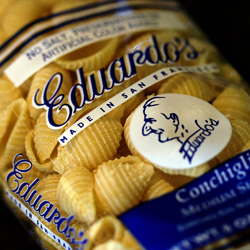 I don’t know what it’s like at your house, but holiday weeks around here can be a little nuts. Even if we don’t have a gaggle of family in residence, there’s always some last-minute preparation, either for a landmark meal, a potluck contribution, or an impending trip.
I don’t know what it’s like at your house, but holiday weeks around here can be a little nuts. Even if we don’t have a gaggle of family in residence, there’s always some last-minute preparation, either for a landmark meal, a potluck contribution, or an impending trip.
This year, it was the latter — we’re off to Seattle for the week after Christmas — so when planning our dinners, we wrestled with the extra complication of creating leftover-free meals. Pasta’s always a simple, comforting for Dark Days Challenge meals, but neither of us was really in the mood for our weekly dose of bolognese.
This recipe reminds me a bit of the Pasta e Fagioli with ‘Nduja that’s become a standard in our kitchen: It comes together in a snap, and it’s far more delicious than a simple reading of the ingredients would suggest. But in place of the beans, this version has leafy broccoli (either broccoli raab or broccoli di ciccio work) and the sausage stays crumbly, rather than melting alluringly into the sauce. Any small pasta will do, but I like shells or ear-shaped orecchiette, which catch bits of the sauce in their cups.
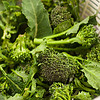
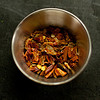
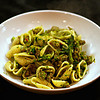


Pasta with Leafy Broccoli and Sausage
— adapted from Kitchen Sense
1/2 to 3/4 pound leafy broccoli (broccoli rabe or broccoli di ciccio)
6 to 8oz small pasta shells or orecchiette
1/4 cup olive oil
1 small white or yellow onion, chopped
3 garlic cloves, minced
a generous pinch of red pepper flakes
1T chopped parsley
1/2 pound mild Italian sausage, removed from casings
freshly grated Parmesan-style cheese
Bring 4 quarts of well-salted water to a hard boil. Meanwhile, trim the tough ends from the broccoli, and cut into 1-inch pieces. (You’ll want to split the florets lengthwise if you’re using di ciccio.) Add the pasta to the water and cook until it’s just beginning to soften, about 4 minutes. Add the broccoli pieces and continue to cook until the pasta is al dente. Reserve about half a cup of the cooking water, then drain the pasta well.
While the pasta cooks, saute the sausage meat in a large skillet over medium heat, breaking into small pieces. When browned. remove to a plate using a slotted spoon, and set aside. Add enough olive oil to generously coat the pan (the amount will vary depending on how much rendered fat you got out of your sausage). Add the onion and sweat until soft; do not brown. Add the garlic and the pepper, and cook until softened.
Add the drained pasta/broccoli to the skillet, along with about 1/4 cup of the cooking liquid. Toss the pasta, adding another 2T of olive oil, or as needed to coat the pasta thoroughly. Add the parsley and more of the cooking liquid if needed to give the dish a sauced appearance.
Serve in wide bowls, scattered with grated Parmesan-style cheese. Makes 2 to 3 main-course servings.
Farmers and food artisans who created the ingredients for this week’s meal: 
Heirloom Organic Farm, Hollister: broccoli di ciccio
Eduardo’s, San Francisco: pasta shells
Bariani, Sacramento: olive oil
Catalán Family Farm, Hollister: onions
Iacopi, Half Moon Bay: garlic
Tierra Vegatables, Santa Rosa: crushed red pepper
Mariquita Farm, Watsonville: parsley
Fatted Calf, Napa: Calabrese sausage
Vella Cheese, Sonoma: dry Jack cheese
Dark Days challenge, locavore
4 Comments »




Posted by Anita on 12.20.09 10:31 PM
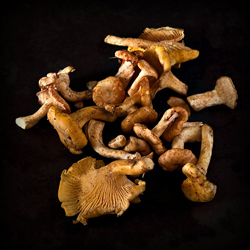 I’m not entirely sure why we haven’t made Miss Lewis’s pork shoulder — a recipe that we’ve swooned over, even declared good enough for company — in an awfully long while. My guess is that it’s because we’re being too picky. You see, we used to be able to reliably source skin-on pork shoulder, but it’s become harder to find, even as we get better and better at finding local pork. And as much as we love the salty, shattering cracking that we’re able to make when we manage to get our hands on a perfect specimen, we really should remember how satisfying this recipe can be, even without its crispy accompaniment.
I’m not entirely sure why we haven’t made Miss Lewis’s pork shoulder — a recipe that we’ve swooned over, even declared good enough for company — in an awfully long while. My guess is that it’s because we’re being too picky. You see, we used to be able to reliably source skin-on pork shoulder, but it’s become harder to find, even as we get better and better at finding local pork. And as much as we love the salty, shattering cracking that we’re able to make when we manage to get our hands on a perfect specimen, we really should remember how satisfying this recipe can be, even without its crispy accompaniment.
This recipe, which came our way via Southern food maven Edna Lewis, is a kissing cousin of our favorite Zuni mock porchetta, but with a deep, lip-smacking sauce that’s perfect for cooler weather. And where porchetta needs little adornment other than the vegetables roasted alongside the pork, its American doppelganger cozies up nicely to mashed potatoes or — even more appropriately — a puddle of creamy grits.
Speaking of which, we took a few liberties for this week’s Dark Days Challenge meal. Although we’ve got a few sources for cornmeal here in the Bay Area, we’re still grits-less. Happily, our friend Kristina of Tennesee Locavore brought us a bag of her favorite local grits as a hostess gift during the BlogHer Food conference. Much like Jeanne’s cranberries, we’re counting this hand-carried gift as an honorary local staple. But everything else in the pan and on the plate was readily found within our 100-mile radius.


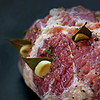
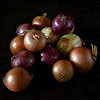
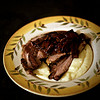
Bay-Studded Pork Shoulder with Wild Mushroom Sauce
– adapted from The Gift of Southern Cooking
1 pork shoulder, preferably bone-in and skin-on
1-1/2 tsp salt
1-1/2 tsp cracked peppercorns
1-1/2 tsp dried thyme
3 cloves garlic, peeled and thinly sliced lengthwise
12 whole, small bay leaves
1 onions, peeled and thickly sliced
up to 1 bottle red wine (or half wine and half port)
—
2T unsalted butter
2C mixed wild mushrooms
salt and pepper
1 shallot, minced
2 small cloves garlic, minced
2T finely minced parsley
1/2 cup heavy cream
The night before, or at least 3 hours before cooking, rinse and dry the pork shoulder. Cut twelve equally-spaced slits in the skin side of the meat, about 1 inch deep and 1-1/2 inches deep. Mix together the salt, pepper, and thyme, and pinch a bit into each slit, followed by a garlic slice and a bay leaf. (The leaves will stick out above the surface of the meat, making them easy to remove after cooking.) Rub the remaining seasoning on the meat, cover loosely and refrigerate.
About an hour before cooking, bring the pork to room temperature. Preheat the oven to 325°F. Place the onion slices on the bottom of a shallow roasting pan or baking dish just large enough to hold the roast. Top with the prepared pork shoulder, then pour the wine into the bottom of the pan, enough to come about halfway up (but not immerse) the pork. Lay a piece of parchment over the pork, then wrap the entire pan tightly with heavy-duty foil (or a double thickness of regular foil). Braise for 4-1/2 to 5 hours, until the meat is very tender.
While the pork is roasting, clean the mushrooms and cut into 1/3-inch slices.
When the pork is finished, remove from the oven. Place the meat on a platter or cutting board and set aside in a warm place. Remove the bay leaves from the pork and discard. Strain the braising liquid, discarding the onions and other solids, and skim most of the fat. (If you’re lucky enough to have found a skin-on pork shoulder, remove the skin at this point and finish the crackling in a very hot oven while you make the sauce.)
Heat the butter in a large skillet until foaming subsides. Add mushrooms and cook over medium-high heat, stirring as needed, until just beginning to brown. Season with salt and pepper; add the shallot, garlic, and parsley and saute, taking care not to overbrown the aromatics. Pour in the strained and defatted braising liquid and boil over high heat until reduced to a syrupy consistency. Reduce heat to medium and add the heavy cream and simmer until heated through. Adjust seasoning to taste.
To serve, slice the pork shoulder thinly against the grain; serve with a piece of crackling on the side and the mushroom sauce spooned over the meat.
Farmers and food artisans who created the ingredients for this week’s meal: 
Marin Sun Farms, Point Reyes: pork shoulder
Guisto’s Vita-Grain, South San Francisco: sea salt
Iacopi, Half Moon Bay: garlic
Spring Hill Cheese Company, Petaluma: butter
Dirty Girl Produce, Santa Cruz: shallot
Mariquita Farm, Watsonville: parsley
Straus Creamery, Petaluma: cream
Catalán Family Farm, Hollister: onions
Walter Hansel Winery, Russian River Valley: wine
Far West Fungi, Moss Landing: chanterelle and yellowfoot mushrooms
…and our own homegrown bay leaves and thyme
Exemptions: black pepper, grits
Dark Days challenge, locavore, recipes
9 Comments »




Posted by Anita on 12.13.09 1:21 PM
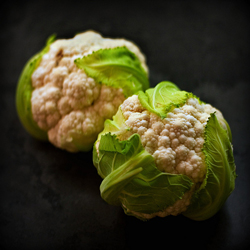 I like to think of myself as a spontaneous person, but I can be… shall we say “resistant”?… to last-minute changes. I’m trying to change, to become a little more flexible, and when I break out of my best-laid plans, oftentimes I’m rewarded.
I like to think of myself as a spontaneous person, but I can be… shall we say “resistant”?… to last-minute changes. I’m trying to change, to become a little more flexible, and when I break out of my best-laid plans, oftentimes I’m rewarded.
A case in point: On Monday, I made a delicious-sounding braised brisket from the October issue of Gourmet. I’d been thinking all weekend about how I would document the recipe for this week’s Dark Days Challenge meal. I planned photos, even brainstormed ideas describing brisket as the perfect braise for chilly autumn.
But although the brisket itself cooked up to a melting perfection (and the ingredients made for some pretty pictures) the sauce was too tomato-y and sweet, a rather one-dimensional result. Definitely not the sort of recipe I like to share with you here. Luckily, we had a pantry and fridge full of other local options, and another few day’s worth of possibilities before the weekly roundup. It took us until Friday night to find a recipe worth sharing, but oh was it worth the wait.
I’ve started collecting chicken recipes in an effort to keep our weekly CSA deliveries from becoming too mundane. No matter how much we love roast chicken (and love it we do) it’s hard for me to work up enthusiasm, week in and week out, for even the most perfectly golden bird. We’ve got a nice little rotation going: Pan-seared, braised, pot pies, jambalaya, coq au vin — it’s all good. But we’re always on the lookout for new ideas to keep things fresh.
When I came across this recipe in one of my favorite cookbooks, I couldn’t even remember the last time I’d made chicken paprikash. I vaguely recalled a version made with boneless, skinless chicken breasts and low-fat sour cream from my deluded college years. But as we prepped the ingredients, it became increasingly clear that this hearty braise was nothing like the over-stewed, excessively tart rendition of my youth.
Tempted by the rich, spicy smells we’d endured for close to an hour, we dove into our meals. Silence descended on the table, broken only by “wow”s and “mmm”s. As he polished off the last bite, Cameron looked me in the eye and said: “That is definitely a keeper.” I was too busy licking my plate to disagree.
Maybe it’s the quick dredge in flour that gives the sauce a silky texture. Maybe it’s browning the meat in bacon drippings — never a bad idea when it comes to flavor. Maybe it’s the addition of fresh frying peppers, alongside the usual dried paprika. Or maybe it’s the rich swirl of crème fraiche at the end, instead of garden-variety sour cream. Whatever the reason, this particular version transcends the genre’s often-lackluster norm.
There’s just one small problem: Like most braises, even the world’s most delicious chicken paprikash looks like a pile of mush. Which explains why you’re looking at the beautiful Swanton cauliflower that we served alongside our brown, lumpy main course. Our first of the year, each head was the size of a softball at most, and mineral-y sweet. Instead of steaming it as we usually do, we quick-braised the florets in a shallow pan; I’m more convinced than ever that just about every vegetable tastes amazing cooked this way.
If I were making this meal over again — especially if I were planning on photographing it — I might choose a green vegetable for a side dish. But honestly, I don’t know how we could have enjoyed it any more.
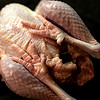

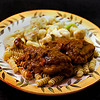


Chicken Paprikash
– adapted from Kitchen Sense
a 4- to 4.5-pound chicken, cut into 10 even pieces
2T oil
2T bacon fat, lard, or additional oil
1/2 cup all-purpose flour
1 medium onion, chopped
1 large garlic clove, minced
1 large or 2 large small Italian frying peppers, seeded and chopped
2T sweet Hungarian paprika (or a mix of sweet + hot)
1 cup chicken stock
1/2 cup white wine
1 large ripe tomato, peeled and cut into chunks, or 2 canned/frozen tomatoes, cut up
1/2 cup crème fraiche or sour cream
Rinse the chicken parts in cold water, and pat dry. Generously season the pieces with salt and pepper.
Heat the oil and bacon fat in a dutch oven or other heavy, wide pot over medium-high heat. Dredge the chicken in flour, shaking off any excess, and place each piece in the hot fat, skin side down. Fry the chicken, turning as needed, until golden brown on all sides. Remove the chicken to a clean plate and keep warm near the stove.
Reduce heat to medium. Add the onion and garlic and cook until soft but not brown. Add the peppers and continue to cook until soft. Add the paprika and cook for a minute or two until you smell the spice; do not brown or it will turn bitter. Add the stock, wine, and tomato and stir well. Return the chicken to the pot, along with any juices from the plate, and nestle into the vegetable mixture; sauce should come about halfway up each piece.
Cover the pot, reduce the heat to low, and simmer for 30 minutes, stirring occasionally. Remove the cover and simmer until the cooking liquid has reduced by about half and the chicken starts to pull away from the leg bones, about an additional 20 minutes. When chicken is done, remove it to a clean plate. Remove the pot from the heat, and stir in the crème fraiche or sour cream. Taste and adjust seasoning as needed.
Serve the chicken over buttered noodles or spätzle, then top each portion with sauce.
Farmers and food artisans who created the ingredients for this week’s meal: 
Soul Food Farm, Vacaville: chicken
Bariani, Sacramento: Olive oil
Guisto’s Vita-Grain, South San Francisco: flour, sea salt(!)
Catalán Family Farm, Hollister: onions & garlic
Happy Quail Farm, East Palo Alto: frying peppers
Walter Hansel Winery, Russian River Valley: wine
Bellwether Farms, Sonoma: crème fraiche
Eduardo’s, San Francisco: pasta
Swanton Berry Farm, Davenport: cauliflower
…and our own home-cured bacon (rendered for fat), home-canned chicken stock, and homegrown tomatoes
Exemptions: paprika, black pepper
Dark Days challenge, locavore, recipes
6 Comments »




Posted by Anita on 12.06.09 1:49 PM
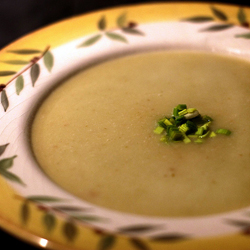 Some weeks — in fact, pretty much every week, if I’m being honest — I spend an hour or two each Friday night planning out the next seven days’ meals. I comb through the fridge and make a list of all the bits and pieces that didn’t get used up from the last market trip. Then I build a week’s menus based on what needs to get used up, and what we’re both craving. I almost always leave one or two dinners open either to market inspiration, or spontaneous (read: laziness-induced) dining out.
Some weeks — in fact, pretty much every week, if I’m being honest — I spend an hour or two each Friday night planning out the next seven days’ meals. I comb through the fridge and make a list of all the bits and pieces that didn’t get used up from the last market trip. Then I build a week’s menus based on what needs to get used up, and what we’re both craving. I almost always leave one or two dinners open either to market inspiration, or spontaneous (read: laziness-induced) dining out.
The only problem with this scheme is that sometimes we find ourselves at home without anything planned for dinner. Usually we’re content with something from the freezer — planned leftovers of stew, chili, or other easy-keeping meals — but this week we still had lots and lots of produce left from our last Mariquita Mystery Box delivery.
A big bunch of baby leeks and a handful of French red fingerling potatoes seemed like the natural base for a hearty, late-fall soup. I’ve made potato-leek soup before, but this version — where a small amount of bacon gets pureed into the base of the soup, rather than scattered on top — is now my all-time favorite. I can neither confirm nor deny that I ate two full bowls of the velvety, smokey stuff. Served with nothing more than a bowl of chilled radishes alongside and a scattering of the season’s first green garlic on top, it made for a perfect impromptu supper.
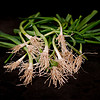




Potato-Leek Soup
adapted from Emeril Lagasse
1 pound leeks
2 bay leaves
20 black peppercorns
4 sprigs fresh thyme
2 T butter
2 strips bacon, chopped
1/2 cup dry white wine
5 cups chicken stock
1 pound starchy potatoes, peeled and diced
1-1/2 tsp salt
1/4 tsp white pepper
1/2 cup cream
2 T finely minced green garlic, chives, or tender leek greens
Tie together bay leaves, peppercorns and thyme into a cheesecloth bundle or infusing ball. Cut the white part of the leeks lengthwise and rinse well under cold water. Slice crosswise and set aside. Discard the greens, or save for making stock.
In a large saucepan, melt the butter over medium heat; when melted, add the bacon. Cook, stirring occasionally, until the bacon is soft and has rendered most of its fat; do not brown. Add the chopped leeks and cook until softened, about 5 minutes. Add the wine and bring to a boil. Add bouquet garni, chicken stock, potatoes, salt, and white pepper, and return to a boil. Reduce the heat to a simmer and cook for 30 minutes, or until the potatoes are falling apart.
Remove the bouquet garni and puree the soup with an immersion blender (or in batches — carefully — in a standard blender; then return to pan). Stir in the cream and adjust seasoning. Serve immediately, with minced chives or green garlic sprinkled over each bowl.
Farmers and food artisans who created the ingredients for this week’s meal: 
Mariquita Farm, Watsonville: potatoes, baby leeks
Spring Hill Cheese Company, Petaluma: butter
Clover Organic, Petaluma: cream
Page Wine Cellars, Napa: wine
Tairwa Knoll Farms, Brentwood: green garlic
…plus homegrown thyme & bay leaves; home-canned chicken stock; home-cured bacon
Exemptions: Salt, pepper
Dark Days challenge, locavore, recipes
5 Comments »




Posted by Anita on 11.30.09 9:46 AM

With all the hullabaloo about 100-mile Thanksgiving, I’m going to go out on a limb and say that this is possibly the easiest Dark Days Challenge week of the year. Maybe it’s because we’ve done this for three years now, and our holiday menu rarely changes much. Maybe it’s because nobody thinks it’s odd to plan this particular meal far in advance, including ordering the main course well before the first leaves turn colors. Maybe it’s because Thanksgiving is one of the few times each year when Americans eat with the seasons, whether they’re aware of it or not. But to me, planning a locavore Thanksgiving celebration isn’t just fun, it’s also pretty simple.
My mom, sister, and brother-in-law joined us this year, and our family feast included a big pasture-raised bird from Bill Niman’s BN Ranch, with all the traditional sides: Shredded brussels sprouts sauteed with bacon, mashed potatoes and gravy, Grandma Anne’s stuffing, and a new-to-us recipe for sweet potatoes that kicks the usual sickly-sweet toppings to the curb with thyme and a dash of red pepper. And it wouldn’t be Thanksgiving without a big slice of pumpkin pie to round out the food coma. (I don’t like pumpkin, but I’ll boldly claim once again this pie will win over even the most vehement squash haters.) Our only non-local dishes were two bowls of cranberry sauce — one plain, one fancy — but since our friend Jeanne bought the berries direct from the Cape Cod farmer who grew them and toted them home in her carry-on bag, I’m not going to lose a lot of sleep over this little lapse.
Some in our family would say that the best part of Thanksgiving is actually the leftovers, including turkey/pork-sausage hash with poached eggs, a riff on Chuck’s holiday turkey gumbo (made with local Dungeness crabs in place of shrimp), and of course good-old turkey sandwiches on delicious homemade bread.
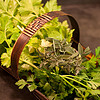



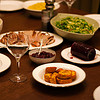
Farmers and food artisans who created the ingredients for this week’s meal:
BN Ranch, Bolinas: Heritage turkey
Mariquita Farm, Watsonville: russet potatoes, sweet potatoes
Balakian Farms, Reedley: pumpkin
Dirty Girl Produce, Santa Cruz: shallot
Catalán Family Farm, Hollister: onions
Fatted Calf, Napa: bacon
Spring Hill Cheese Company, Petaluma: butter
Guisto’s Vita-Grain, South San Francisco: flour (pie crust, stuffing bread)
Clover Organic, Petaluma: cream
Vella Cheese, Sonoma: dry Jack cheese
Iacopi, Half Moon Bay: brussels sprouts, garlic
G&S Farms, Brentwood: corn (stripped and frozen in August)
Bariani, Sacramento: Olive oil
Soul Food Farm, Vacaville: pastured eggs
Hamada Farms, Kingsburg: clementines
Fleur, Napa and Mackenzie, Sebastopol: wine
…and our own homegrown sage, parsley, celery, and thyme
Exemptions: Salt, pepper, sugar, yeast, nutmeg, cinnamon, cranberries (hand-carried from Massachusetts by Jeanne)
Dark Days challenge, Eat Local Challenge, holidays & occasions, locavore
4 Comments »




 The display read 101°F when the digital thermometer beeped, which might have been okay if we were proofing yeast. But we were in the bedroom, not the kitchen — and the thermometer was under the tongue of my very achy, very sick wife. “You are not going to work,” I said. “And I am coming home early and making chicken soup.”
The display read 101°F when the digital thermometer beeped, which might have been okay if we were proofing yeast. But we were in the bedroom, not the kitchen — and the thermometer was under the tongue of my very achy, very sick wife. “You are not going to work,” I said. “And I am coming home early and making chicken soup.”































































